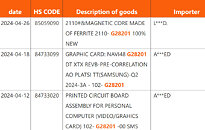- Joined
- Oct 9, 2007
- Messages
- 47,217 (7.55/day)
- Location
- Hyderabad, India
| System Name | RBMK-1000 |
|---|---|
| Processor | AMD Ryzen 7 5700G |
| Motherboard | ASUS ROG Strix B450-E Gaming |
| Cooling | DeepCool Gammax L240 V2 |
| Memory | 2x 8GB G.Skill Sniper X |
| Video Card(s) | Palit GeForce RTX 2080 SUPER GameRock |
| Storage | Western Digital Black NVMe 512GB |
| Display(s) | BenQ 1440p 60 Hz 27-inch |
| Case | Corsair Carbide 100R |
| Audio Device(s) | ASUS SupremeFX S1220A |
| Power Supply | Cooler Master MWE Gold 650W |
| Mouse | ASUS ROG Strix Impact |
| Keyboard | Gamdias Hermes E2 |
| Software | Windows 11 Pro |
A curiously described graphics card was detected by Olrak29 as it was making it through international shipping. The shipment description for the card reads "GRAPHIC CARD NAVI48 G28201 DT XTX REVB-PRE-CORRELATION AO PLATSI TT(SAMSUNG)-Q2 2024-3A-102-G28201." This can be decoded as a graphics card with the board number "G28201," for the desktop platform. It features a maxed out version of the "Navi 48" silicon, and is based on the B revision of the PCB. It features Samsung-made memory chips, and is dated Q2-2024.
AMD is planning to retreat from the enthusiast segment of gaming graphics cards with the RDNA 4 generation. The company originally entered this segment with the RX 6800 series and RX 6900 series RDNA 2 generation, where it saw unexpected success with the crypto-mining market boom, besides being competitive with the RTX 3080 and RTX 3090. This bust by the time RDNA 3 and the RX 7900 series arrived, and the chip wasn't competitive with NVIDIA's top-end. Around this time, the AI acceleration boom squeezed foundry allocation of all major chipmakers, including AMD, making large chips based on the latest process nodes even less viable for a market such as enthusiast graphics—the company would rather make CDNA AI accelerators with its allocation. Given all this, the company's fastest GPUs from the RDNA 4 generation could be the ones that succeed the current RX 7800 XT and RX 7700 XT, so AMD could capture a slice of the performance segment.

View at TechPowerUp Main Site | Source
AMD is planning to retreat from the enthusiast segment of gaming graphics cards with the RDNA 4 generation. The company originally entered this segment with the RX 6800 series and RX 6900 series RDNA 2 generation, where it saw unexpected success with the crypto-mining market boom, besides being competitive with the RTX 3080 and RTX 3090. This bust by the time RDNA 3 and the RX 7900 series arrived, and the chip wasn't competitive with NVIDIA's top-end. Around this time, the AI acceleration boom squeezed foundry allocation of all major chipmakers, including AMD, making large chips based on the latest process nodes even less viable for a market such as enthusiast graphics—the company would rather make CDNA AI accelerators with its allocation. Given all this, the company's fastest GPUs from the RDNA 4 generation could be the ones that succeed the current RX 7800 XT and RX 7700 XT, so AMD could capture a slice of the performance segment.

View at TechPowerUp Main Site | Source






